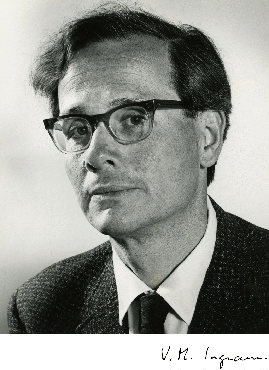Vernon Ingram facts for kids
Quick facts for kids
Vernon Martin Ingram
|
|
|---|---|
 |
|
| Born |
Werner Adolf Martin Immerwahr
19 May 1924 |
| Died | 17 August 2006 (aged 82) |
| Nationality | German |
| Alma mater | University of London |
| Spouse(s) | Elizabeth Ingram |
| Children | Peter, Jennifer |
| Awards | William Allan Award (1967) |
| Scientific career | |
| Fields | Biology |
| Institutions | MIT |
| Doctoral advisor | Fred Barrow |
Vernon Martin Ingram (May 19, 1924 – August 17, 2006) was a German-American professor of biology at the Massachusetts Institute of Technology (MIT). He is famous for a very important discovery about how a tiny change in a protein can cause a disease.
Contents
About Vernon Ingram
Early Life and Moving to England
Vernon Ingram was born in a city called Breslau, which was in Germany at the time. His birth name was Werner Adolf Martin Immerwahr. When he was 14, his family had to leave Nazi Germany. They were Jewish and did not agree with the Nazi government's actions. They moved to England, where he changed his name to Vernon Ingram.
Studying Chemistry
During World War II, Vernon worked in a factory that made medicines for the war. At night, he studied at the University of London. He earned a degree in chemistry in 1945. Later, in 1949, he got his PhD in organic chemistry.
Working with Proteins
After his PhD, Vernon worked at different research places. He studied proteins, which are tiny building blocks inside our bodies. In 1952, he went back to England and worked at the Cavendish Laboratory at the University of Cambridge. There, he continued to study proteins.
His Big Discovery: Sickle Cell Disease
In 1956, Vernon Ingram made a huge discovery about a blood disease called sickle cell disease. People with this disease have red blood cells that are shaped like a crescent moon, not round. This can cause many health problems.
Vernon found out that the problem was caused by a tiny mistake in a protein called haemoglobin. Haemoglobin is found in red blood cells and carries oxygen. He showed that in people with sickle cell disease, just one tiny part of the haemoglobin protein was different. A normal protein has something called glutamic acid at a certain spot, but in sickle cell haemoglobin, it's replaced by something called valine.
He used special methods called electrophoresis and chromatography to see this tiny change. This was the very first time anyone showed that a single change in a protein could cause a disease. Because of this, Vernon Ingram is sometimes called "The father of Molecular Medicine." This means he helped start the field of studying diseases at a very tiny, molecular level. In 1967, he won the William Allan Award for his amazing work.
Life at MIT
In 1958, Vernon Ingram joined the faculty at MIT in the United States. He planned to stay for only a year, but he liked it so much that he stayed there for the rest of his career. At MIT, he kept working on haemoglobin. He also became interested in how haemoglobin in babies is different from that in adults.
Later, in the 1980s, Vernon became interested in brain diseases, especially Alzheimer's disease. His second wife, Elizabeth, worked with people who had intellectual disabilities. She noticed that people with Down syndrome often developed Alzheimer's disease when they were older. This sparked Vernon's interest in studying the disease.
Later Years and Legacy
Even after he retired, Vernon Ingram continued his research at MIT. He and his wife, Beth, were also "housemasters" at Ashdown House at MIT for 16 years. This meant they lived there and helped guide the students.
An asteroid (a small rocky object in space) called 6285 Ingram was named in their honor! From 1989 to 1999, Vernon was also the Director of the Experimental Study Group at MIT. This is a special program for college students.
In 2002, he was chosen to be a member of the United States National Academy of Sciences. This is a very high honor for scientists in the U.S.
Vernon Ingram passed away in Boston, Massachusetts, on August 17, 2006, after a fall.
See also
- MIT Biology Department
- Intrabody (intracellular antibody)
- Huntingtin and Huntington's disease
- Sickle cell anaemia and Hemoglobin

